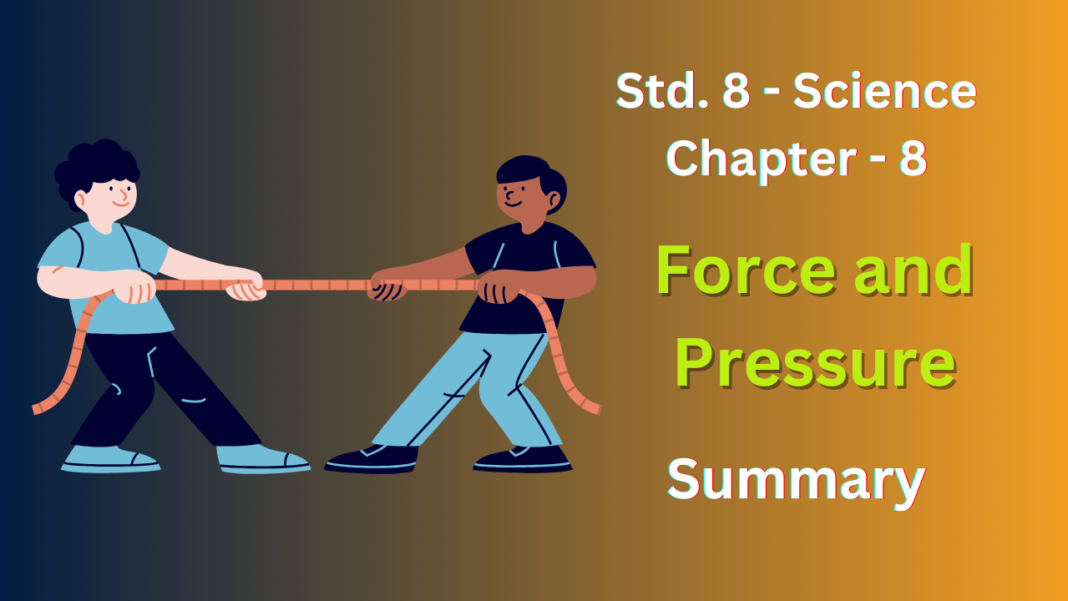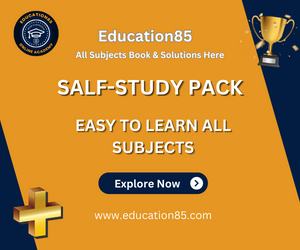NCERT Solutions for Class 8 Science Chapter 8
- A push or a pull on an object.
- Can cause an object to start moving, stop moving, change direction, or change shape.
- Measured in Newtons (N).
Effects of Force:
- Change in Speed: A push or pull can speed up, slow down, or stop an object completely.
- Change in Direction: Force can make an object move in a different direction.
- Change in Shape: Force can bend, stretch, or crush an object.
Types of Forces:
- Contact Forces: When two objects touch and one exerts a force on the other (e.g., kicking a ball).
- Non-Contact Forces: When a force acts on an object without touching it (e.g., gravity pulling an apple down).
Pressure:
- Force applied per unit area. Imagine the force spread out over a surface.
- Pressure = Force / Area (higher force or smaller area leads to higher pressure).
- Measured in Pascals (Pa).
Applications of Pressure:
- Sharp Objects: Sharper objects have a smaller area, concentrating the force for easier cutting (e.g., knife).
- Buoyancy: Pressure difference between the bottom and top of an object allows it to float (e.g., boat).
- Airplanes: Shape of wings creates different pressures above and below, generating lift.
NCERT Solutions for Class 8 Science Chapter 8
Q1. Give two examples each of the situations in which you push or pull to change the state of motion of object
Ans: Push: swing, soccer ball. Pull: door, wagon.
Q2. Give two examples of situations in which applied force causes a change in the shape of an object.
Ans: Bend straw, inflate balloon.
Q3. Fill in the blanks in the following statements.
(a) To draw water from a well we have to ______ at the rope.
(b) A charged body ______ an uncharged body towards it.
(c) To move a loaded trolley we have to ______ it.
(d) The north pole of a magnet _______ the north pole of another magnet.
Ans:
- Pull
- Attracts
- push
- Repels
Q4: An archer stretches her bow while taking aim at the target. She then releases the arrow, which begins to move towards the target. Based on this information fill up the gaps in the following statements using the following terms: muscular, contact, non-contact, gravity, friction, shape, attraction
(a) To stretch the bow, the archer applies a force that causes a change in its ______ (b) The force applied by the archer to stretch the bow is an example of ______ force. (c) The type of force responsible for a change in the state of motion of the arrow is an example of a ______ force.
(d) While the arrow moves towards its target, the forces acting on it are due to _______ and that due to _____ of air.
Ans:
- Shape
- Muscular
- Non contract
- Gravity and friction
Q5. In the following situations identify the agent exerting the force and the object on which it acts. State the effect of the force in each case.
(a) Squeezing a piece of lemon between the fingers to extract its juice.
(b) Taking out paste from a toothpaste tube.
(c) A load suspended from a spring while its other end is on a hook fixed to a wall.
(d) An athlete making a high jump to clear the bar at a certain height
Ans:
(a) Squeezing a lemon:
- Agent: Fingers
- Object: Lemon
- Effect: The lemon’s shape changes, and juice is extracted
.(b) Taking out toothpaste:
- Agent: Fingers
- Object: Toothpaste tube
- Effect: The toothpaste paste is squeezed out of the tube.
(c) Load suspended on a spring:
- Agent: Load (weight)
- Object: Spring
- Effect: The spring stretches due to the weight pulling it down.
(d) Athlete making a high jump:
- Agent: Athlete’s legs (muscles)
- Object: Ground
- Effect: The athlete pushes off the ground, propelling them upwards to jump over the bar.
Q6. A blacksmith hammers a hot piece of iron while making a tool. How does the force due to hammering affect the piece of iron?
Ans: Hammering reshapes hot iron and strengthens it.
Q7. An inflated balloon was pressed against a wall after it had been rubbed with a piece of synthetic cloth. It was found that the balloon sticks to the wall. What force might be responsible for the attraction between the balloon and the wall?
Ans: The force responsible for the attraction between the balloon and the wall is electrostatic force.
Q8. Name the forces acting on a plastic bucket containing water held above ground level in your hand. Discuss why the forces acting on the bucket do not bring a change in its state of motion.
Ans: There are two main forces acting on a plastic bucket containing water held above ground level in your hand:
- Muscular Force: This is the force exerted by your muscles as you grip and hold the bucket upwards.
- Gravitational Force: This is the force of gravity pulling the bucket (and the water inside) downwards towards the Earth.
Q9. A rocket has been fired upwards to launch a satellite in its orbit. Name the two forces acting on the rocket immediately after leaving the launching pad.
Ans: Thrust Force: This is the powerful upward force generated by the rocket’s engine due to the combustion of propellants and expulsion of hot gases. This force propels the rocket upwards.
Gravitational Force: This is the force of gravity exerted by Earth, pulling the rocket downwards towards the planet’s centre.
Q10. When we press the bulb of a dropper with its nozzle kept in water, air in the dropper is seen to escape in the form of bubbles. Once we release the pressure on the bulb, water gets filled in the dropper. The rise of water in the dropper is due to
(a) pressure of water
(b) gravity of the earth
(c) shape of rubber bulb
(d) atmospheric pressure
Ans: (d) Atmospheric pressure
NCERT Solutions for Class 8 Science Chapter 8
FAQ’s
What topics are covered in NCERT Solutions for Class 8 Science Chapter 8?
The NCERT Solutions for Class 8 Science Chapter 8 cover topics such as force, pressure, types of forces, and their effects on objects.
How can NCERT Solutions help me understand force and pressure better?
NCERT Solutions provide detailed explanations, examples, and exercises that help you grasp the concepts of force and pressure effectively.
Are there any real-life applications of force and pressure discussed in this chapter?
Yes, the chapter discusses various real-life applications of force and pressure, such as the functioning of machines, hydraulic systems, and more.
Are there any practical activities or experiments included in this chapter?
Yes, NCERT Solutions often include practical activities or experiments related to force and pressure that you can perform to gain a better understanding of the concepts.
How can I use NCERT Solutions to prepare for exams related to force and pressure?
By practicing with NCERT Solutions, you can strengthen your understanding of force and pressure concepts, which will help you perform well in exams and solve related problems confidently.









